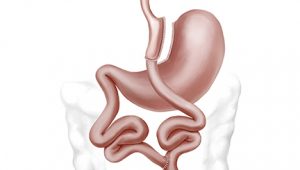The Roux-en-Y Gastric Bypass is a restrictive and malabsorptive procedure. These two mechanisms help achieving a significant weight loss.
The restrictive part is achieved as the surgeon divides the original stomach to create a small stomach or pouch, about the size of an egg. This limits the amount of food you can eat. Second, the small bowel is divided and re-routed. The remnant stomach (remaining stomach) will be bypassed by connecting a loop (100 – 150 cm) of the small intestine to the pouch. As some of the small intestine is bypassed as well, this will cause a state of malabsorption. The segment of intestine attached to the pouch is free of acid and enzymes required for digestion and absorption to take place. Together these two surgical alterations restrict the amount of food intake and the amount of calories and nutrients absorbed.
This surgery will result is an early sense of fullness (satiety) and satisfaction, a reduced desire for food, and rapid weight loss.
Advantages of the Roux-En-Y Gastric Bypass Surgery
The advantages of gastric bypass surgery are many. Most patients experience an improvement in medical conditions, a decrease in prescription medications, improved fertility in females, and an improved quality of life.
- No bands or other foreign objects in your body.
- An established procedure with more research on safety and effectiveness than any other procedure.
- More weight loss in the first year than the gastric sleeve and the adjustable gastric band (lap-band).
- Reversible if necessary (but not easily).
- Can be revised to a longer-limb Roux-en-Y gastric bypass if an initial short-limb procedure does not lead to expected weight loss.
- Quick improvements in your health, especially in your blood sugar control with better insulin resistance, lower blood sugar levels and possible resolution of diabetes.
- May be a good choice for individuals with a sweet tooth because sweet foods will lead do dumping syndrome (not well tlerated by patients).

